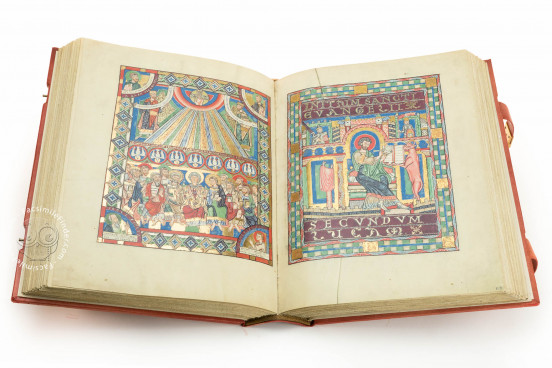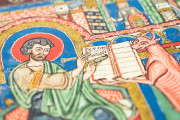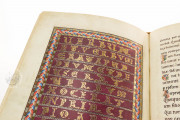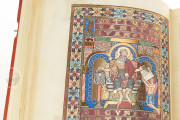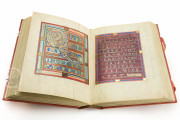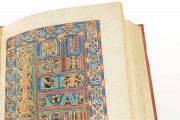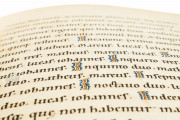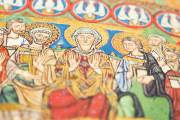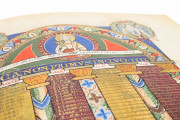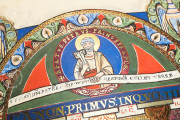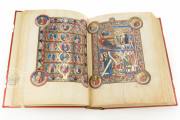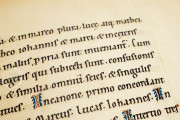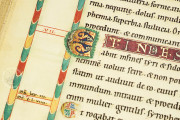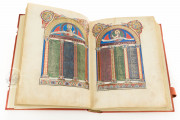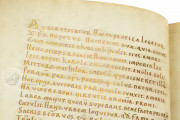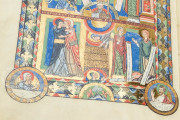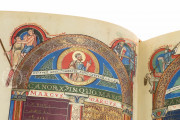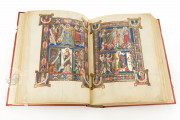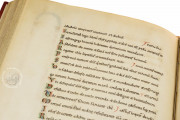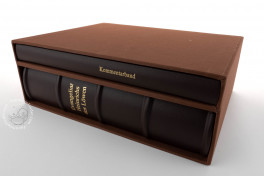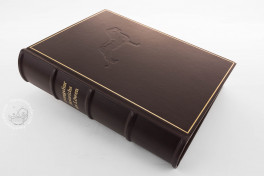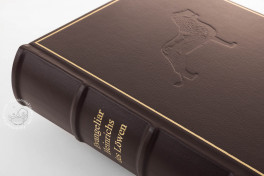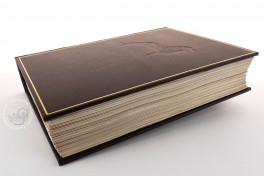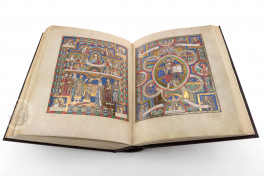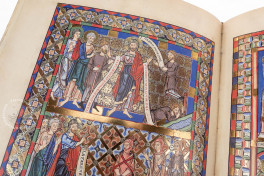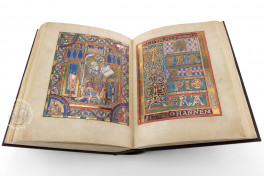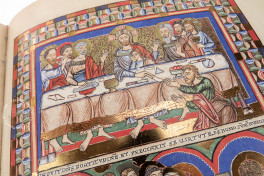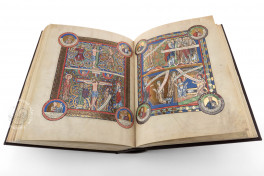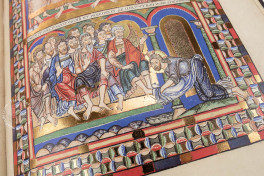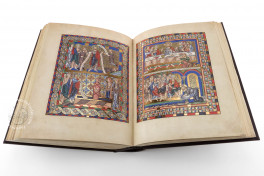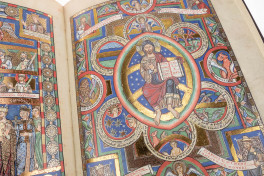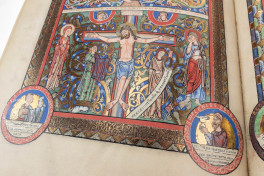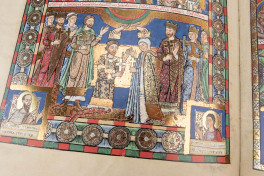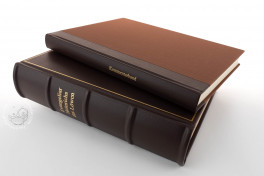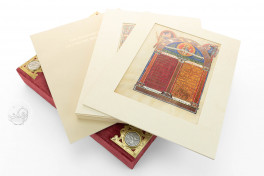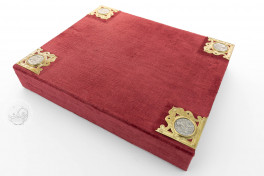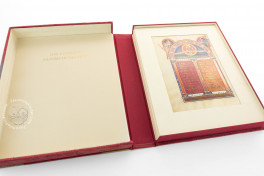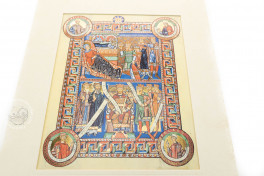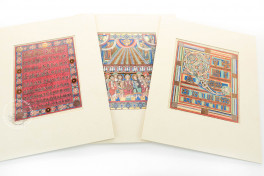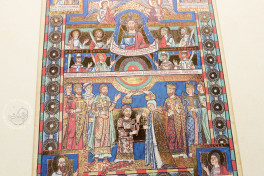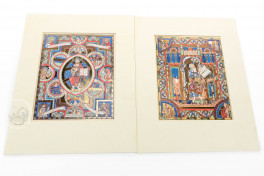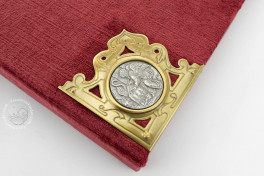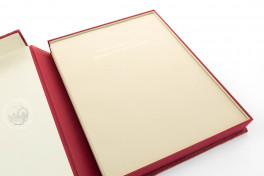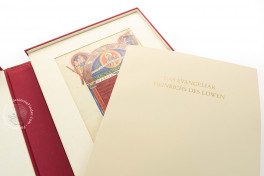The Gospels of Henry the Lion is one of the most lavish examples of Romanesque illumination from central Germany. The codex, also known as Evangeliar Heinrichs des Löwen, was written and illuminated in the last quarter of the twelfth century in the Benedectine monastery of Helmarshausen and features fifty full-page miniatures, along with a small number of canon panels and several historiated initials. With its shimmering gold combined with the use of vivid colors, this manuscript is a masterpiece of Romanesque German production.
Produced between 1175 and 1188, the manuscript takes its name after Henry the Lion (ca. 1130-1195). Written in Latin, this Gospel contains the text of the four gospels, to be used in the solemn service in Brunswick Cathedral on the occasion of the consecration of the Altar of Our Lady in 1188.
Coronation Miniature of the Evangeliar Heinrichs des Lowen
The picture cycle of the Gospels of Henry the Lion shows that it is based on an iconographic concept. The multilayered references reveal a comprehensive theological and literary education on behalf of the authors. The miniatures stand out because of their extremely complex program and their immediate historical content.
The miniature on fol. 171r, representing the coronation scene, is one of the most stunning depictions of the manuscript. The picture shows the coronation of Henry the Lion and his wife Mathilde by Christ. Behind his kneeling duke, his parents, Duke Henry the Proud and Duchess Gertrude, as well as his grandparents, Emperor Lothar III and Empress Richenza.
The upper half of the figure shows Christ surrounded by eight saints who are close to the ducal house, including Thomas Becket, Archbishop of Canterbury. This miniature is interpreted as the reception of the crown of eternal life as well as the dedication of the duke pair to the community of the righteous. This is also indicated by the fact that the princely figures hold crosses in their hands.
Carolingian and Ottonian Influences of the Gospels of Henry the Lion
The two central themes of the picture are the succession of Christ and the promise of eternal life. The picture cycle betrays a Carolingian and Ottonian influence from older imperial gospels, however, although the manuscript uses it as a model it does not fall into pure imitation.
Typical of Romanesque book painting, the most artistically striking feature of this miniature along with the others is the almost complete fusion of the figurative representation with the ornament, by which the combination of the two elements results in a detailed play of color.
The effect is that of a very shimmering depiction with gold and silver outshining each other. A vivid purple is often applied in order to contrast the glaring page, granting to the image the highest splendor. With no neutral element running through the image, the miniatures are not open to the readers, but require attentive observation on their part urging the beholder to read the depictions as well as the text.
It is worth noticing that although there is an attempt to fill in every empty space either with ornaments or architectural representations (horror vacui), the miniatures do not appear clustered or confusing, for they are structured following a composition which is almost geometrically organized.
Superb Example of Protogothic Script
The script of the Evangeliar Heinrichs des Lowen belongs to the twelfth century, which marks a period of transition in the history of medieval scripts. This period witnessed a shift between Caroline minuscule and Gothic, and this codex is a beautiful example of such transition often labeled Protogothic.
There is a narrowing of the letter bodies, so that the almost circular lobe of o tends to become oval; furthermore, the shading, the contrast between bold and thin strokes is more distinct. Another script that can be identified in the manuscript is the Rustica Quadrata which has no contractions and few punctuation marks.
Helmarshausen Monastery and Its Ostracized Bishop
The commissioner of the work was Henry the Lion himself, who from 1152 until his trial for insubordination in 1180, held the bishopric of the abbey of St. Mary and St. Peter. Thusly connected to the Benedectine monastery, he made sure that the Gospel would be part of Helmarshausen superb production.
In the last few lines it is stated that the work was made by a monk named Herimann, on the orders of the abbot Konrad (II.) Von Helmarshausen, who followed the order of duke Henry. However, it is possible that other scribes collaborated to the making of the manuscript.
We have 3 facsimiles of the manuscript "Gospels of Henry the Lion":
- Evangeliarium Heinrici Leonis facsimile edition published by Insel Verlag, 1988
- Das Evangeliar Heinrichs des Löwen facsimile edition published by Insel Verlag, 1988
- Das Evangeliar Heinrichs des Löwen (Collection) facsimile edition published by Coron Verlag, 1986

